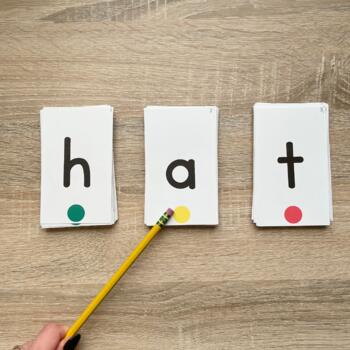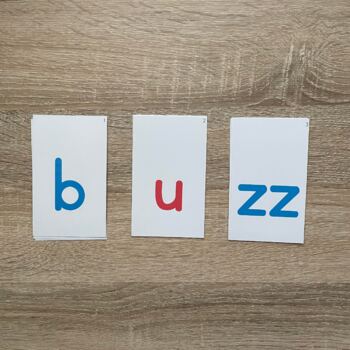Phoneme Grapheme Blending Letter Cards EDITABLE
- Zip
What educators are saying
Description
OVERVIEW
These Orton-Gillingham inspired card packs are an excellent tool to support your students’ continued reading development! The cards consist of 178 concepts, including short vowels, consonants, consonant blends, digraphs, vowel teams, r-controlled vowels, welded sounds, diphthongs, and other word endings, including -s, -es, -ed, and Magic E. These cards have been intentionally crafted to complement any scope and sequence you are currently using and are ideal for students in grades K-2 or students needing remedial reading support.
WHAT’S INCLUDED
Phoneme Grapheme Cards Teacher Guide
This teacher guide will walk you through the materials included within our pack and provide you with recommendations for use. It also contains specific steps, hints, and reminders regarding how to use these cards efficiently and effectively for blending drills. Blending drill tips are not included in this TpT product description but are included in the teacher guide, and we recommend reading through it thoroughly prior to initial use!
Phoneme Grapheme Teacher Checklist
This checklist can be used to keep track of which concepts you have introduced to your students. You can also use it as an individual data tracker for each student, noting which concepts your students can decode and spell. The checklist is organized by the position cards should be used during a blending drill — all the cards in the initial position are listed first, followed by the second position cards, and finally, the third.
Editable Phoneme Grapheme Teacher Checklist
This editable teacher checklist could be used in several ways. If you are using a program following a specific scope and sequence, you can input the scope and sequence of your program into this checklist to simplify organization of your cards. Additionally, you could begin with a blank teacher checklist and write in new concepts as you introduce them to your students.
Phoneme Grapheme Cards (Black Letters)
These phoneme grapheme cards come in three different sizes: 3x5, 4x6, and 5.5x8.5. Letters are printed in black with a white background. These cards can be printed on white cardstock. You could also consider printing on different colored cardstock to distinguish between consonant and vowel units or to note the location of each concept (first, second, or third position) when blending. Within this card deck, there are four “special” cards with different colors: suffixes -s, -es, and -ed, in addition to Magic E. Because these cards do not go in the first, second, or third position and have special roles, they have a star in the top right corner, indicating a fourth position.
Phoneme Grapheme Cards (Blue and Red Letters)
These phoneme grapheme cards come in three different sizes: 3x5, 4x6, and 5.5x8.5. These cards highlight the difference between consonant and vowel units. Consonant units are printed in blue, and vowel units are printed in red. Within this card deck, there are four “special” cards with different colors: suffixes -s, -es, and -ed, in addition to Magic E. Because these cards do not go in the first, second, or third position and have unique roles, they are in different colors from the blue and red letters, indicating a fourth position.
Phoneme Grapheme Cards (Black Letters with Green, Yellow, and Red Dots)
These phoneme grapheme cards come in two different sizes: 3x5 and 4x6. These cards are intended to provide students with a kinesthetic opportunity to practice blending. They can tap the colored dots beneath the letters as they state the sounds. Letters have one of three colored dots beneath them: green, yellow, or red. Color specifies where the card should go during a blending drill. Green dots indicate first position, yellow cards indicate second position, and red cards indicate third position. Within this card deck, there are four “special” cards with different colors: suffixes -s, -es, and -ed, in addition to Magic E. Because these cards do not go in the first, second, or third position and have special roles, they have black dots beneath them, indicating a fourth position.
Editable Card Pages
These editable card pages come in three sizes: 3x5, 4x6, and 5.5x8.5. Use the pages to add any concepts you are working on with your students that are not already included within our packs.
HOW TO USE
These phoneme grapheme blending board cards were inspired by the Orton-Gillingham approach, which uses these blending board cards in two primary ways.
- Practicing Sounds in Isolation: Teacher holds up a card for students to view. Students state the sound or sounds produced by the letter(s).
- Blending Drill: Teacher organizes cards into three piles. Teacher guides students as they first state all three sounds in isolation, and then blend them together. Teacher takes one card away from the first, second, or third pile to reveal a new word. Sound and blending practice is repeated. (More thorough instructions regarding blending drills are included in our teacher guide).
We recommend using these phoneme grapheme cards in ways that align with the Orton-Gillingham approach. However, they could also be used in any number of other way within your classroom, including, but not limited to: Pocket Chart Center, Literacy Games, Letter Formation Reference Tool, Supplement to Phonemic Awareness Instruction, Visuals within Small Group Instruction, Posters within Classroom.
WHY USE PHONEME GRAPHEME CARDS?
Explicit, Systematic Instruction
The National Reading Panel conducted a meta-analysis of the existing research on phonics instruction that was published in 2000. The Panel concluded that systematic phonics instruction is more effective at helping children learn to read than non-phonics instruction. We know that systematic phonics instruction is important, particularly for students in the early grades and students needing remedial reading instruction. However, we don’t always have the resources we need to effectively carry out this instruction. We hope that these phoneme grapheme cards can be a tool used to enhance your current systematic phonics instruction and provide your students with numerous opportunities to practice and review phonics concepts.
Use in Connection with Any Reading Program
We understand that there is more than one reading program out there, and often the scope and sequence of phonics concepts utilized varies from district to district (or changes from year to year within a district). We also know (fortunately) that the specific scope and sequence you use is far less important than whether you are using a sequential, systematic approach to introduce phonics concepts. No matter which sequence you use, our phoneme grapheme cards are compatible. We have an editable checklist for you to enter the order in which you introduce phonics concepts that will help you organize which cards to use with your students. If your curriculum changes and your sequence changes – no problem – these cards will still work! Additionally, if you need a phonics concept we haven’t included, you can add it to any of our editable card decks.
Improve Decoding Automaticity
Reading is hard work at first, and it does not come automatically to most students. Students need repeated opportunities to practice the process of recognizing a visual representation of a sound and translating that representation to speech. Furthermore, once students can identify individual sounds, they need repeated opportunities to practice combining sounds together into meaningful words. When you incorporate these cards as a blending drill into your daily routine, students are time and time again given the opportunity to practice these challenging skills until eventually they can become automatic.
Want to try before you buy? Click here to download our freebie, 3x5 phoneme-grapheme sample cards with tap spots. :)
✻ Level 1 Bundle - Digital Blending Board Google Slides (24,500+ Editable Slides)
✻ Level 1 Bundle - Decodable Word, Phrase, and Sentence Google Slides (5000+ Editable Slides)
✻ Level 1 Bundle - Decode and Dash Fluency Board Game
✻ Level 1 Spelling Dictation Lists
✻ Spelling Dictation Templates
✻ Multisensory Learned Word Foldable
✻ Write and Wipe Word Mapping Mats
***Level 1 = Consonants, Short Vowels, Qu + Consonant Digraphs sh, th unvoiced, th voiced, ch, and wh.
Click HERE to connect with us on Instagram and receive daily literacy tips!
Click HERE to send us an email with any thoughts, ideas, suggestions, or concerns you may have regarding SparkEd Literacy and this product! We will get back to you as soon as possible.





